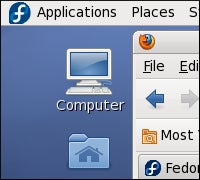 Fedora 12 desktop Click to enlarge. |
Fedora 12, codenamed “Constantine,” made its debut this week, aimed at providing users with a long list of improvements for both servers, desktops and netbooks.
While the latest installment of the Red Hat-sponsored community Linux distribution offers many new features, at the top of the list for users including Fedora’s project leader, Paul Frields, are improved networking capabilities that raise the bar for mobile connectivity on Linux.
“The features that I feel closest to this time, and that have affected me, are the network manager improvements in mobile broadband, which are pretty extensive,” Frields told InternetNews.com. “Not only do we have a provider database that makes it easy to tether your phone to your laptop and get online, but also we’ve got functions to allow use of newer EVDO cards and mobile USB interfaces that are out there.”
In particular, Frields said Bluetooth-based tethering received attention in Fedora 12, to the point where he now considers it to be trouble-free and “foolproof.” He explained that users with Bluetooth connectivity on their mobile phones will simply see their device pop up in the Fedora 12 network manager list as a selectable item, enabling them to easily tether it to their PC for Internet connectivity.
Fedora 12 also provides enhancements that polish up user interface elements like the desktop, making it a friendlier place.
“Some of the things that have happened there are more noticeable and less frequent notifications with a new theme that makes them more visible,” Frields said. “There are bits of rearrangement here and there with panel icons and other desktop theme items, where it’s just got little more fit and finish that makes it more pleasant from a usability point of view.”
From a developer and troubleshooting perspective, Fedora 12 includes an improved version of the Systemtap utility. According to Frields, Systemtap 1.0 provides more granular user features for tracing and debugging programs.
“This is something that will be really useful to people that are actually developing solutions on an open source platform,” he said. “Not only does it have better debugging and tracing capabilities, it takes advantage of some changes in the way the kernel code is written so that it’s easier to find problems, diagnose them and correct or improve code.”
As anticipated, Fedora 12 also gives virtualization a boost. Among the new virtualization features is improved memory management to reduce duplication across virtual machines. There is also the ability to remotely boot virtual machines over a network included in Fedora 12.
Fedora serves different masters
The new Fedora 12 release comes at the end of a busy Linux release season with rivals Ubuntu and openSUSE both pushing out their own respective updates in recent weeks.
Fedora 12 is also sure to be a closely watched release. In some respects, Fedora serves as the research and development project for Red Hat Enterprise Linux, with features from the community edition known to make their way into the Red Hat’s (NYSE: RHT) core offering.
But Fedora also serves other purposes, according to Frields.
“Fedora has to serve quite a lot of different masters,” Frields said. “Anyone that comes into the Fedora project needs to be able to effectively use Fedora as a research and development lab. Red Hat does that, but anybody could do that.”
For example, Fedora 12 offers netbook enhancements that Frields noted came from a community contributor.
In Frields’s view, what Fedora does is it provides a set of building blocks of well-engineered open source software.
“Anybody that has a specific area that they’re interested in will be able to mold Fedora into a product that they can put out in front of people,” he said. “Whether you call it a spin or a Fedora remix, Fedora is malleable enough to turn out some very different kinds of project.”
Moving forward, Frields sees users moving to Fedora, and to open source software in general, as an alternative to proprietary software that isn’t keeping pace.
“We’re being assisted by the fact that proprietary software is not getting better at the pace that people expect,” Frields said. “People expect an increasing rate of evolution and proprietary software is not capable of sustaining that rate. That is driving people to look for alternatives.”


